|
Let’s Rap About Dectes Stem Borer In Soybean … Not As Bad As You Think

DR. SCOTT STEWART
JACKSON, TENN.
Over the years and several times in the last month, I’ve had folks tell me how bad Dectes stem borer hurt their soybean yields. Almost without exception, they describe low yielding spots in their fields and/or weak, dying, and dead plants … and they found a lot of Dectes larvae in the stems. They are convinced the two are related and look at me like I’m crazy when I suggest they are not. Here’s what I know. Don’t forget to look at the photos included at the bottom of this article!
What do we know about the biology and pest status of the Dectes stem borer?
• Dectes stem borer has multiple hosts, notably including ragweed and sunflower.
• There is one generation per year.
• They overwinter as larvae inside and at the base of stalks. Overwintering larvae will be at or below the soil level (very similar to southwestern corn borer in non-Bt corn).
• Larvae pupate in the spring and adults emerge over a period of several weeks, typically during June in Tennessee.
• Adults are strong fliers and can infest fields from a distance.
• Adults prefer to lay eggs in plants that have a little size on them, often during R1-R3 growth stages of indeterminate soybean varieties. You will definitely see where the adults pick on varieties that are at the right growth stage when they emerge.
• Females can lay many eggs during her life, but she deposits her eggs singly inside a soybean leaf petiole in the mid and upper part of the canopy. There may be several different eggs laid on a single plant.
• Larvae spend there entire life on the inside of the plant, first tunneling within the leaf petiole and then entering the main stem. Thus, foliar insecticide applications may kill adults but have little or no effect on larvae.
• The leaves of infested petioles will eventually turn brown and drop from the plant at about the time the larva moves into the stem (see picture). Thus, they do cause some minor defoliation.
• By the time the larvae is full sized, it has tunneled the inside of the stalk all the way to the base of the plant where it will spend winter. The larvae typically mature about the same time as the soybean plant. It may be hard to believe, but data showing that this tunneling directly affects yield is hard to come by and questionable. Indeed, our data indicates no yield loss as a result of stem tunneling.
• Larvae are cannibalistic, so you rarely find more than one mature larva in a plant.
• In preparation for overwintering, the larvae often girdle the stem near the base of the plant by chewing around its circumference (from the inside). Thus, some stems may break and lodge before harvest. This injury can can yield loss, mostly by reducing harvest efficiency. Do not confuse this with ‘regular lodging’ where the plants simply lay or bend over. With Dectes, there will be a relatively clean break at the site of the girdle, and the larvae will be present in the stem below the break.
• Any lodging that occurs is unpredictable, and significant levels are only rarely seen before fields are harvested. No one fully understands why lodging occurs in one field and not another, even though both are heavily infested. It sometimes appears variety related, but I’ve not been able to replicate that observation in test plots. I’ve left heavily infested soybean stand for many weeks after they were ready to harvest without seeing significant lodging, and then you see that rare field where the opposite happens.
• In short, the potential for meaningful yield loss is from lodging, which is relatively rare and unpredictable. I’ve tried and have not been able to replicate the conditions that cause this lodging.
What should I do about Dectes stem borer?
• Given their biology, it is not surprising that Dectes populations are higher in no-till areas. Because they overwinter in the base of plants, tillage can kill overwintering larvae. However, this will have considerably less impact in no-till areas unless it is done across a large area because adults can readily infest from neighboring fields or from weedy hosts. And of course, tillage is not a good production practice for many fields of West Tennessee.
• Most importantly, harvest heavily infested fields as soon as they are mature to reduce the chance of a significant lodging event. Unfortunately, by the end of the season, many fields may be infested at levels of 50-90 percent in some years.
• You generally can’t spray insecticides timely and often enough to provide good control because the adults come out over several weeks and lay many eggs that are protected within the plant. It’s even less effective when there is high pressure. Thus, insecticide applications are typically not cost effective (and not recommended).
• One caveat here, there is some data showing that applications of chlorantraniliprole (Prevathon or Besiege), at least at high rates and when repeated, can kill the larvae. But it’s very questionable whether this is cost effective, and again, not recommended. It’s an expensive option considering meaningful lodging occurs in a small percentage of fields.
• In summary, foliar insecticide applications are not recommended because they don’t work well, and anyway, the risk of lodging in low.
Don’t fool yourself!
I’ve never seen a Dectes stem borer kill a plant. If your plants are turning brown or withering, there’s a good chance you are dealing with a pathogen like stem canker, anthracnose, charcoal rot, or taproot decline. I’ve walked many heavily infested fields where the grower points out how many Dectes there are in the ‘bad spot’ only to show them they were just as numerous in the good spots.
To reinforce my comments above, I wanted to share some data collected sometime ago in Tennessee, Arkansas, and and couple of other locations. My colleagues, including Dr. Gus Lorenz, and I were testing an insecticide seed treatment (fipronil). This insecticide is not and will not be labeled for use in soybean, but it does a good job at killing the larvae before they do significant tunneling in the stems. As you will see in the table, we had high average infestation levels of Dectes across many trials. The seed treatment provided good control, but yields were not consistently improved by this seed treatment. We might have seen a yield response if significant lodging occurred in these trials, but it did not. The take home is that stem tunneling had no obvious effect on yield. It’s apparent that the pith of that soybean stem is essentially dead tissue, so feeding by the larvae is not hurting the plant. ∆
DR. SCOTT STEWART: IPM Extension Specialist, University of Tennessee
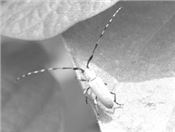
Adult Dectes stem borer
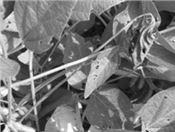
Dead leaf caused by Dectes
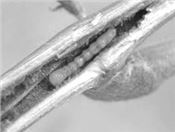
Larva inside stalk
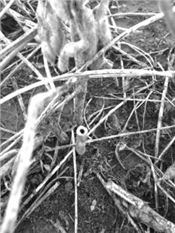
Dectes girdled stalk
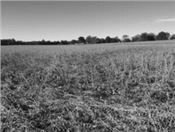
Field with lodging
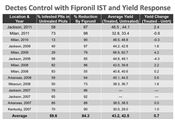
|
|